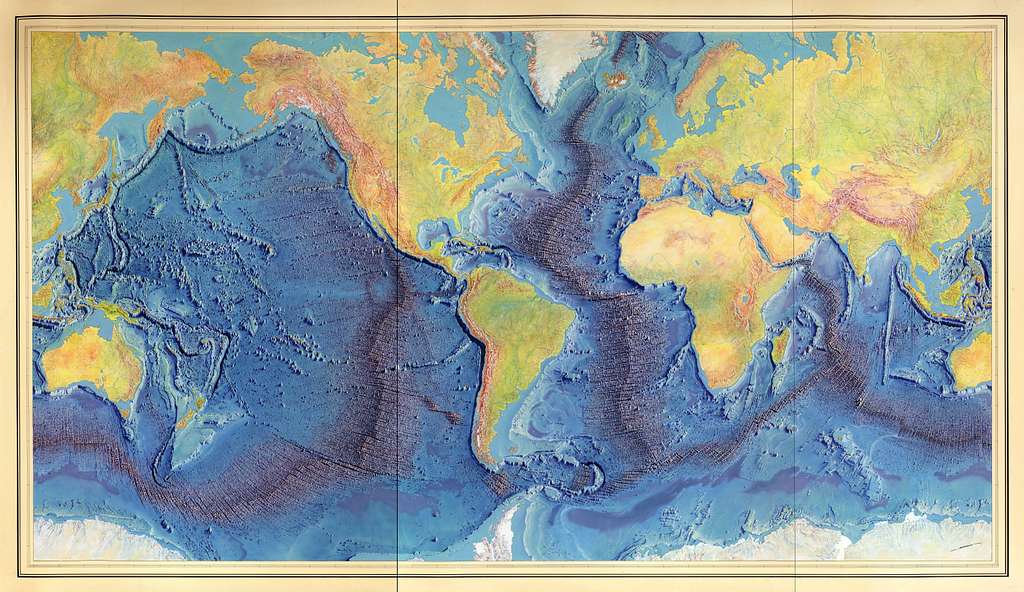
Some 50 years ago, researchers discovered a leak in Earth’s oceans. Judging by the chemistry of the leak, it seemed to be coming from the mantle. This seemingly small realization is actually huge.
If the leak was connected to the mantle, it would mean the seafloor must be spreading somehow, to make way for the mantle material to emerge. If the seafloor is spreading in some places, then it’s pushing material around — and on the other side of the planet, other parts of the ground are smushed together.
In more geological terms, if you have a divergent boundary (where the ground is pushed apart), you must also have a convergent boundary (where the ground is pushed together).
It gets even more interesting: since seafloor spread seems to be happening in more than one place, then it means that there are multiple boundaries, both divergent and convergent. If this is the case, then the Earth’s surface isn’t uniform, but rather split into different plates.
We now call these plates “tectonic plates”, and the theory behind how all this works is called “plate tectonics.”
Plate tectonics has transformed our understanding of the Earth’s physical characteristics and its evolution. It states that the movement of these plates is driven by heat deep within the Earth’s mantle, and the plates glide, move apart, and collide with each other.

Tectonic plate movement is slow but relentless. As an approximation, the plates move at about the same speed your fingernails grow. But this slow movement is responsible for virtually all the geological features we see today — from the mountain ranges to the deep sea rifts. Before plate tectonics, we lacked a good understanding of how mountains form and earthquakes take place.
“Before the birth of plate tectonics theory, studying geology was essentially an exercise in collecting (apparently disparate) facts and memorizing information. Structural geology was concerned with descriptions and understanding deformation for its own sake,” writes expert Yong-Fei Zheng in an article describing how impactful plate tectonics has been.
Plate tectonics definition
It’s hard to sum up such a complex theory in simple, approachable terms. But here goes.
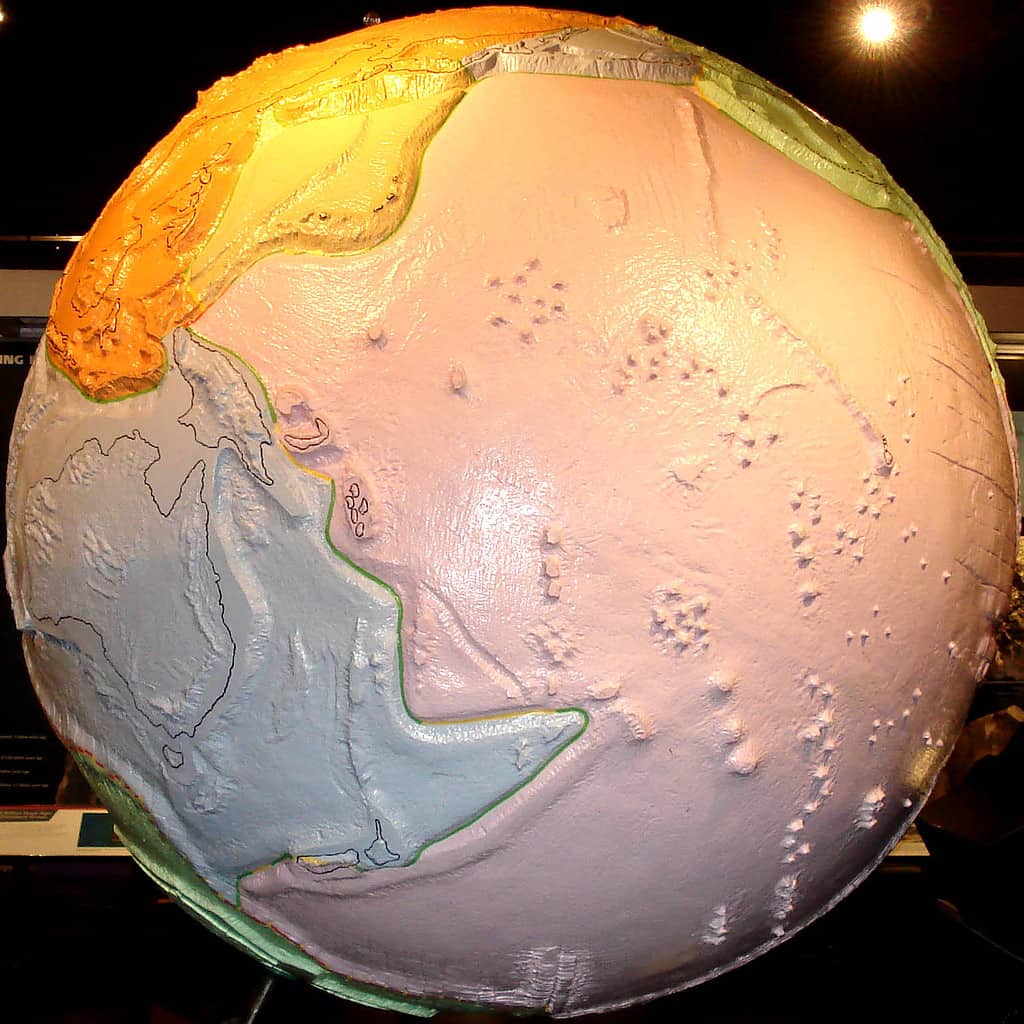
The Earth’s outermost layer, extending to about 100 miles (160 kilometers) deep, consists of approximately 15 robust, rigid rock plates. These plates, akin to ice floes on a river, shift in relation to each other. We call this layer the lithosphere.
Beneath these plates lies a layer of rock known as the asthenosphere, which is near its melting point and serves as the sliding layer for plate tectonics. The majority of Earth’s deformation, along with the occurrence of earthquakes and volcanoes, takes place at the boundaries of these plates.
These boundaries are sites of divergent movement, like along the Mid-Atlantic Ridge; convergent movement, as seen in island arcs and deep-sea trenches such as Japan; or lateral sliding, as observed along California’s San Andreas fault.
The concept of plate tectonics is not just a theory about the Earth’s structure; it’s a unified framework for understanding the Earth’s geology. It explains the location of earthquakes, volcanoes, mountain ranges, and other geological phenomena. It also provides a basis for understanding the Earth’s past, such as the existence of supercontinents like Pangaea and the development of the planet’s distinct continents.
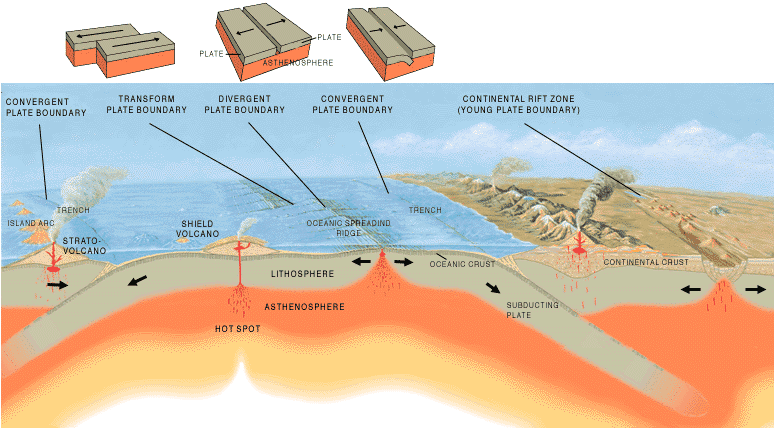
Tectonic plate movement
The seafloor leaks weren’t the “eureka” moment for plate tectonics. In fact, there wasn’t one single ‘eureka’ moment with plate tectonics. Plate tectonics is a unifying theory, so you need multiple types of evidence.
Much of this evidence is extremely complex. But some of it is very simple. So simple, in fact, that a child could make an observation about it. Basically, some continents seem to fit like puzzle pieces. Most notably, South America and Africa.

Granted, this could be a coincidence or explained perhaps by something else. But researchers backed this up by showing that similar fossils were found in Eastern South America and Western Africa. These continents really did seem to have stayed together at some point. We now call these ancient structures, when two or more of today’s continents were joined together, “supercontinents”. Some examples are Pangaea and Gondwana.
But the vents and the fit of the continents weren’t enough to convince geologists.
Earthquakes and mountains as evidence
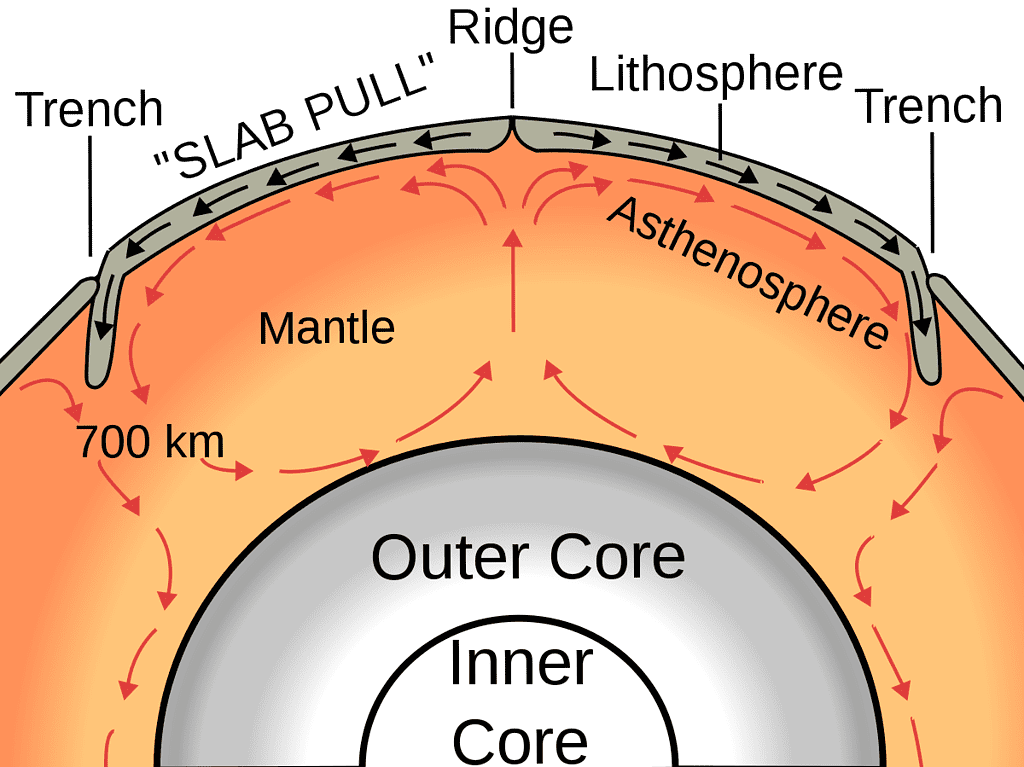
Another piece of key evidence came from earthquakes. For starters, there are a lot of earthquakes (and volcanoes) at places where there would be tectonic edges. There is the notable Ring of Fire, but other edges as well.
Earthquakes also carry with them information. Researchers analyze seismic waves that come from earthquakes to get information about the structure of the Earth. Did you ever wonder how we know so much about the Earth’s mantle and core, for instance, which are hundreds or thousands of kilometers deep, when the deepest hole we’ve dug is about 12 km? It’s mostly seismic waves.
Through seismic waves, geophysicists managed to confirm the proposed structure of the Earth, including the lithosphere and the asthenosphere. They also managed to confirm some of the properties of the mantle (and the crust) that would enable plate tectonics to function.
The boundaries where tectonics spread and collide also confirmed this theory. If crustal plates spread in areas like the mid-Atlantic ridge, then the seafloor around these ridges would be very young. Furthermore, it would be youngest at the center (where matter from the mantle constantly pushes up), and older towards the edges. This is exactly the case.
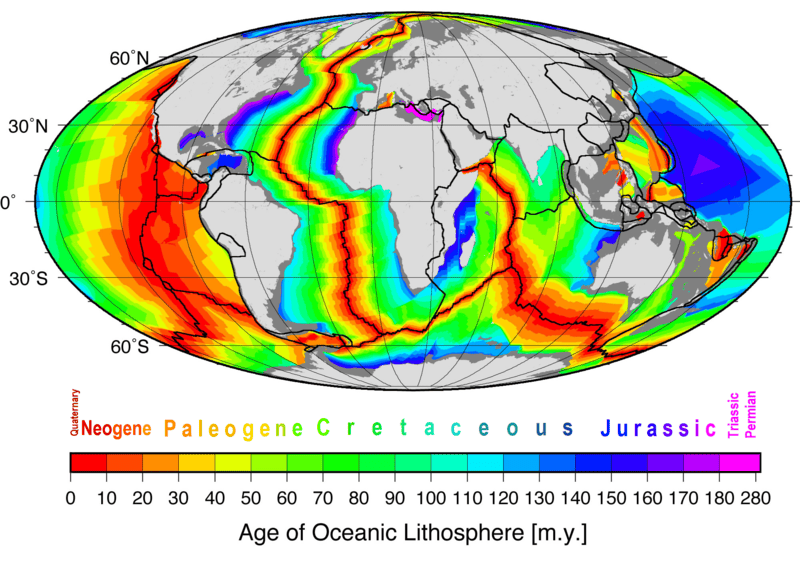
Then, on the other side, we have plate collision: we see this brilliantly in the case of the Himalayas. The Himalayan mountain range, the tallest on Earth, formed as the Indian plate smashed into Asia. Imagine pushing two pieces of paper toward each other: they crumple and push upwards. That’s what’s happening in the Himalayas… except far more complex.
Plate tectonics wasn’t accepted initially. But after several seminal papers, the position of most geologists started to change. Nowadays, plate tectonics is almost universally accepted.
Types of tectonic plates
Tectonic plates are the massive pieces of the Earth’s lithosphere that move, interact, and change over time. They’re kind of like cracked shell pieces moving around on a viscous surface (the mantle).
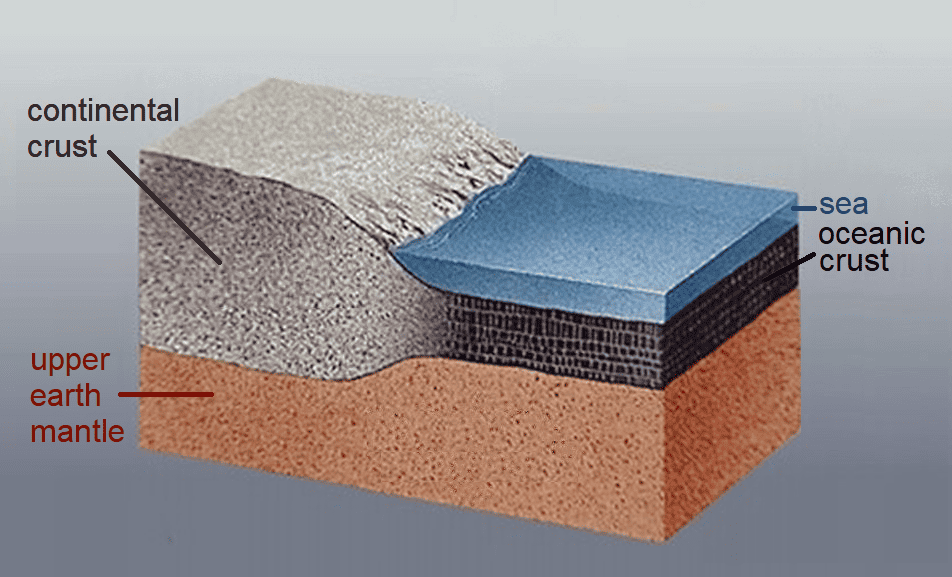
There are two primary types of tectonic plates: oceanic plates and continental plates.
- Oceanic Plates: These are tectonic plates located under the ocean. They are primarily composed of basalt, a dense rock formed from solidified lava. Examples of oceanic plates include the Pacific Plate and the Nazca Plate.
- Continental Plates: These are tectonic plates that form the continents. They are primarily composed of granite, a less dense rock than basalt. Examples of continental plates include the North American Plate and the Eurasian Plate.
As the name implies, oceanic plates consist of oceanic crust — while continental plates consist of continental crust.
Continental crust is thicker but lighter than the oceanic crust. This is because the rocks in the oceanic plates (basalts) are denser.
This also helps to explain what happens when tectonic plates collide. When an oceanic plate collides with a continental plate, the denser oceanic plate tends to slide under and is recycled in the mantle. This process is called subduction (we’ll get to it in more detail in a moment).

But when two continental plates collide, they have similar densities, so it’s not easy for one to slide beneath the other. So what basically happens is that they crumple up. This process is what lead to the formation of some of the tallest mountain ranges on Earth, like the Himalayas.
Of course, these processes are not simple. In fact, geologists today are still actively researching all these tectonic processes, trying to figure out exactly what happens. It’s not easy, but we’re getting more and more information, and our understanding of plate tectonics, while still incomplete, is improving every year.
“Most present-day motions of the earth’s plates are well understood. We have known since the 1960s that plate motion is very concentrated in the oceans, but more diffuse [elsewhere], especially in Asia. We still don’t understand that diffuse motion very well. When in the earth’s history plate tectonics started is still widely debated,” says Lynn Sykes, one of the pioneering seismologists who worked on plate tectonics.
Tectonic plate map
Among the vast array of geological maps researchers use, the tectonic map is one of the most important.
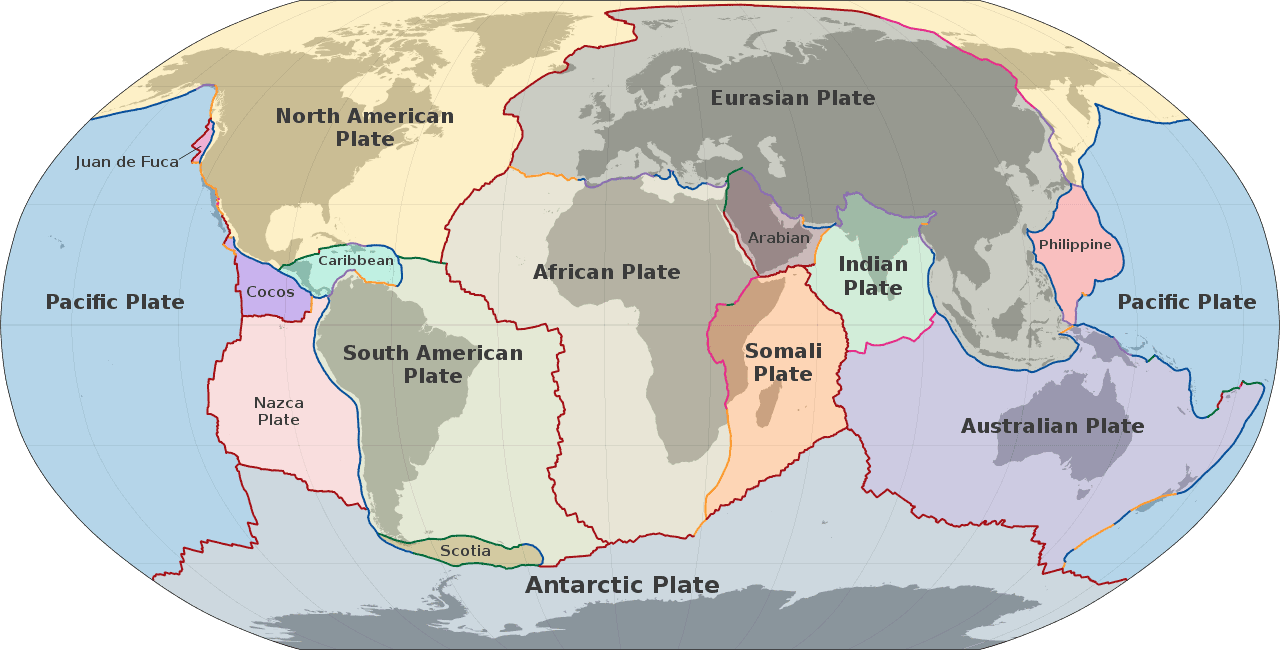
There are seven major tectonic plates on Earth:
- Pacific Plate: The largest tectonic plate, the Pacific Plate, is mostly an oceanic plate covering the Pacific Ocean. This plate extends from the east coast of Japan to the western coast of North America.
- North American Plate: This plate includes not only North America but also part of the Atlantic Ocean and the western part of the Arctic Ocean. It extends eastward to the Mid-Atlantic Ridge and westward to a complex boundary with the Pacific Plate.
- Eurasian Plate: Covering most of Europe and Asia, the Eurasian Plate extends from the Mid-Atlantic Ridge in the west to the Indian Ocean in the east.
- African Plate: This plate includes the entire continent of Africa as well as the surrounding oceanic crust of the Atlantic and Indian Oceans.
- Antarctic Plate: As the name suggests, this plate covers the continent of Antarctica and extends into the surrounding Southern Ocean.
- Indo-Australian Plate: This plate is often considered as two separate plates – the Indian Plate and the Australian Plate – due to the different movement rates. It covers the Indian Ocean, Australia, and part of the Pacific Ocean.
- South American Plate: This plate includes the continent of South America and a portion of the Atlantic Ocean extending to the Mid-Atlantic Ridge.
These major tectonic plates interact with each other at their boundaries, leading to various geological phenomena and shaping the Earth’s landscape.
You could say that these plates correspond to the continents on Earth, but that’s only approximately true, and there are still some that don’t correspond to any continent. But perhaps a better way to put it is that our current, geographical continents don’t correspond to the real geological continents. When researchers say they’ve found a new continent, for instance, they’re referring to a new piece of plate tectonics.
In addition to these, there are also several minor tectonic plates and microplates.
Plate boundaries
Just like how plate tectonics are categorized, so too are their boundaries.
Divergent boundaries

Divergent boundaries, also known as constructive boundaries, are areas where tectonic plates move apart from each other. This movement is driven by the upwelling of magma from the Earth’s mantle, which creates new crust as it cools and solidifies. This is where the “constructive” part comes from.
- Formation and Characteristics: Divergent boundaries are characterized by a process known as seafloor spreading, where new oceanic crust is formed through volcanic activity and then gradually moves away from the ridge. This process often results in the formation of mid-ocean ridges, which are underwater mountain ranges formed by plate divergence. The Mid-Atlantic Ridge is a prime example of this.
- Geological Features: Divergent boundaries can lead to the formation of various geological features. Underwater, they create mid-ocean ridges and can lead to the formation of new islands through volcanic activity. On land, they can create rift valleys, such as the East African Rift, where the continental crust is being pulled apart.
- Volcanic and Seismic Activity: Divergent boundaries are typically associated with significant volcanic and seismic activity. As the plates move apart, magma rises to fill the gap, often leading to volcanic eruptions. Earthquakes can also occur as the crust fractures and moves.
- Role in Plate Tectonics: Divergent boundaries play a crucial role in plate tectonics as they facilitate the creation of new crust. This process contributes to the continuous cycle of crust formation and destruction that drives the movement of tectonic plates.
- Examples: Some notable examples of divergent boundaries include the Mid-Atlantic Ridge, the East Pacific Rise, and the East African Rift. These locations provide valuable opportunities for scientists to study the processes occurring at divergent boundaries.
Convergent boundaries

Convergent boundaries, also known as destructive boundaries, are regions where tectonic plates move towards each other. This movement can lead to various geological phenomena, including the formation of mountain ranges, deep sea trenches, and volcanic activity. Here are some key details about convergent boundaries:
- Formation and Characteristics: Convergent boundaries form when two tectonic plates collide. This collision can involve two oceanic plates, an oceanic and a continental plate, or two continental plates. The nature of the plates involved determines the specific geological phenomena that occur.
- Subduction Zones: When an oceanic plate collides with another oceanic plate or a continental plate, the denser oceanic plate is usually forced under the other in a process known as subduction. This leads to the formation of a deep sea trench and can cause intense volcanic activity.
- Mountain Formation: When two continental plates collide, neither plate is dense enough to subduct under the other. Instead, the crust is pushed upwards, leading to the formation of mountain ranges. The Himalayas, for example, were formed by the collision of the Indo-Australian and Eurasian plates.
- Volcanic and Seismic Activity: Convergent boundaries are associated with significant volcanic and seismic activity. The subduction of one plate under another can lead to the formation of volcanic arcs, while the intense pressure and friction at these boundaries can trigger powerful earthquakes.
- Examples: Notable examples of convergent boundaries include the collision between the Eurasian and Indian plates (forming the Himalayas), the subduction of the Nazca Plate beneath the South American Plate (forming the Andes), and the subduction of the Pacific Plate beneath the Mariana Plate (forming the Mariana Trench).
Transform boundaries

Transform boundaries, also known as conservative boundaries, are regions where two tectonic plates slide past each other horizontally. These boundaries are unique in the sense that they neither create nor destroy the lithosphere. Here are some key details about transform boundaries:
- Formation and Characteristics: Transform boundaries form when two tectonic plates slide past each other horizontally. This lateral movement is due to the differential rates of seafloor spreading at divergent boundaries. The edges of the plates at these boundaries are often jagged, leading to the plates becoming locked together, causing a build-up of stress.
- Faults and Earthquakes: The primary geological feature associated with transform boundaries is faults, specifically strike-slip faults. These faults occur when the movement along the fault line is horizontal. The stress build-up from the locked plates can eventually be released in the form of an earthquake. Therefore, transform boundaries are often associated with seismic activity.
- Notable Examples: The most famous example of a transform boundary is the San Andreas Fault in California, where the Pacific Plate and the North American Plate slide past each other. Other examples include the North Anatolian Fault in Turkey and the Dead Sea Transform fault in the Middle East.
- Role in Plate Tectonics: Transform boundaries play a crucial role in plate tectonics as they accommodate the movement between other types of boundaries. They often connect segments of diverging or converging boundaries, forming a complex network of geological activity.
- Impact on Landscape: Unlike convergent and divergent boundaries, transform boundaries do not result in significant changes to the Earth’s topography. However, the intense seismic activity can lead to noticeable surface shifts and damage in populated areas.
Beyond plate tectonics
It hasn’t been long since plate tectonics was accepted as the major unifying geological theory. It’s striking to think that we developed nukes before we figured out how earthquakes happen — and it’s also pretty humbling. We don’t know everything about plate tectonics, and we may never understand truly everything, but with each study, we’re getting one more puzzle piece.
We know the forces that drive plate motion — or we think we do — but we don’t know many of the details. Furthermore, no mechanism can be truly tested to explain everything about plate tectonics. But perhaps the biggest unknown regarding plate tectonics is that no known mechanism can explain all the facets of plate movement. The currents inside the mantle, the ones that drive all this, are still pretty mysterious.
Could there be yet another, even better theory that comes up eventually? It’s definitely possible. It’s also possible that our plate tectonics knowledge is still rough and needs finessing.
The fact that tectonic plates exist, that they’ve been moving in the past, and are continuing to move now is undeniable. The fact that this shapes our planet is also well understood. But the details of why and how they move is still an area of active research. To make matters even more complex, there could be plate tectonics on other celestial bodies, which we currently know very little about. No doubt, there’s still plenty of work to do when it comes to these tectonic plates.


